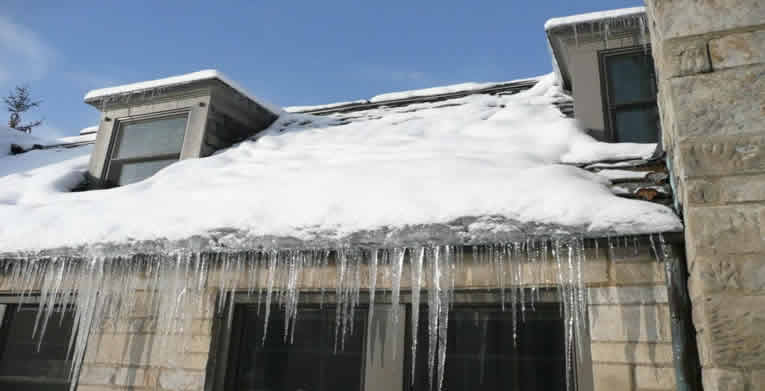If you experience an ice dam on your roof then you have to take action quickly or risk serious and expensive damage to your home or injury to yourself, family member or passerby.
An ice dam is a build-up of ice on your roof. Ice dams can seriously damage your roof, tear apart your gutters, strip paint, damage insulation and affect interior drywall and other surfaces.
They are also dangerous to the structural integrity of a building and pose a health risk to people. When an ice dam appears you must take immediate action to treat the problem.
To prevent an ice dam forming you must start by improving ventilation under the roof deck of your home. You should also reduce the amount of heat that accumulates in your attic.
Clearing away snow from the edges of the roof will also help prevent ice dams from forming. If you already have an ice dam then you must take additional measures that we will discuss below, as this activity can be dangerous.
Table of Contents
How ice dams are formed by heat in your attic
If you live in an area of the country that experiences heavy snowfall then you will have seen more than a few ice dams in your time.
Ice dams form when snow lies on a roof that is being subjected to internal heat. The heat from the roof starts to melt the snow but as the snow melts into water it runs down the roof towards colder parts of the structure where the cold weather quickly turns the water into ice.
Poor guttering can greatly increase the formation of an ice dam as the melting snow water cannot be removed from the roof before it freezes.
Most ice dams are most visible at the very edges of the roof.
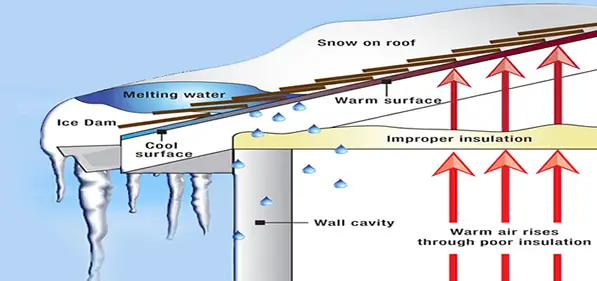
The 3 ways heat causes ice dam build up
As already mentioned ice dams form at the edge of the roof. As heat in the roof causes the snow to melt further away from the edges, it is obvious that some form of rising internal heat is raising the temperature of the roof at a point.
This heated area of roof then continually melts the snow but as the water runs down towards the edges, where the roof is colder, it freezes forming an ice dam.
The heat that hits the center of the roof is usually heat that is rising from within the living area of the house. In very rare cases heat from the sun can cause these temperature differences.
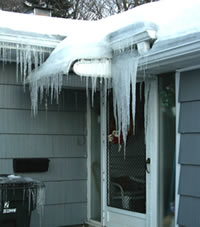 So how does the heat travel from the lower parts of the house up to the attic?
So how does the heat travel from the lower parts of the house up to the attic?
Heat from the living spaces of a house will usually rise to the attic and roof area in one of three ways.
They are:
- Conduction
- Convection
- Radiation
Let’s look at these in a bit more detail.
I will use an example of a pot on a stove to help you better understanding these 3 forms of heat.
1. Through conduction
Conduction refers to heat that travels through a solid object.
You will have experienced the effect of conduction if you have ever tried to the lift the handle of an iron pot that is on a stove!
Although the handle is nowhere the heat source the heat energy travels up the pot and into the handle through conduction.
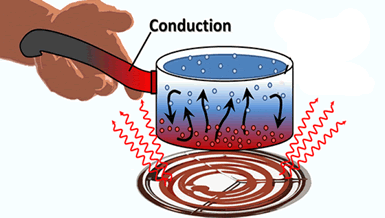
2. By convection
Convection happens to the liquid inside the pot.
Convection the movement caused within a fluid when hotter and less dense material is caused to rise while colder denser material is caused to sink.
This results in the transfer of heat.
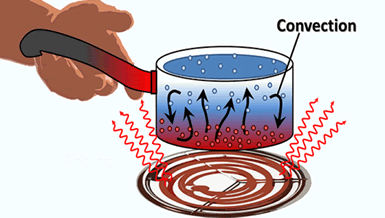
3. Via radiation
Radiation refers to the heat you feel directly from the heat source.
With respect to our pan on the stove example the radiation is the heat that is being generated and sent out by the stove.
Another example is the heat you feel from the sun.
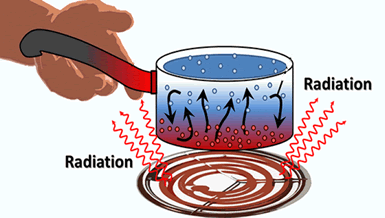
Why Ice Dams Are Dangerous
Ice dams are bad for both your home and they can pose a serious health risk to , your family and anyone who visits your home.
How ice dams can severely damage buildings
When heat reaches your attic and thus your roof area via one, or all, of the 3 methods described above your roof will become heated in the spot directly above the heat source.
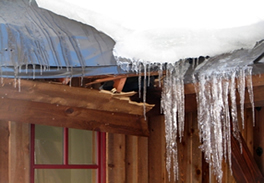 As the edges of your house are not generally in contact with this heat they remain as cold, or almost as cold, as the outside temperature.
As the edges of your house are not generally in contact with this heat they remain as cold, or almost as cold, as the outside temperature.
As the ice builds-up at the edges of the roof it can further exacerbated the problem by forming a dam that stops other melting snow water from draining off the building.
Soon you can have a major accumulation of ice on your roof.
As the ice builds-up on the heated area of the roof it then melts again and can soak into the roof sheathing eventually leaking into your attic.
Once this happens the damage starts to accumulate. As the water leaks into the attic it can then leak through drywall ceilings affecting lower areas of the house.
Ice dams aren’t just a danger to the structural integrity of your home
Very heavy ice dams can weaken the structural integrity of your roof. If left untreated they can create very costly damage.
However, Ice dams do not only pose a serious problem to your house, they also pose a serious health risk to people.
As ice dams start to melt it is not uncommon for them to fall off roofs in large sheets.
Such a large heavy sheet of ice could cause serious injury or even death to a passer-by.
There are a lot of reported yearly injuries and deaths caused by falling ice dams and probably a lot more than go unreported.
Dangerous iice dams falling off a roof (video)
How to Prevent Ice Dams
By far the most effective steps you can take to prevent ice dams is to ensure your attic is heat-free or as free from heating sources as possible.
This can be a problem for people who live in winter-cold areas and who therefore need to ensure their homes are insulted from the cold as much as possible.
Regardless of how cold it gets outside though you must try to keep heat out of your attic or you will experience ice dams on your roof.
Install some simple roof ventilation
The best way to prevent an ice dam forming is to ensure there is adequate ventilation under the roof deck as this will help keep that area as cold as possible by allowing cold air access.
To prevent ice dams the underside of your roof deck should be as close to the temperature outside the building as it is possible to get it.
This ventilation should help to provide cold air flow to the peak or ridge of your roof.
Minimize the amount of heat escaping into the attic
As best you can try to actually insulate your attic against heat.
Even simple things such as attic lights can generate enough heat to lead to ice dam build-up.
Other heat sources that could leak into the attic include duct-work that has not been insulated and improperly vented bathroom exhaust fans.
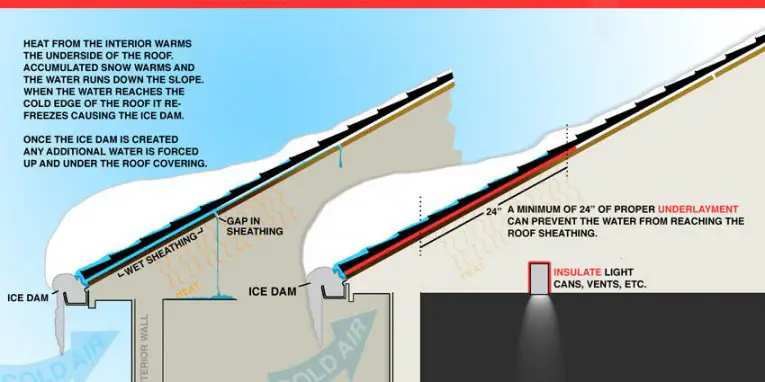
How to Deal With An Existing Ice Dam
Taking steps to prevent these hazardous winter menaces is by far the best action you can take, but what do you do when you already have ice dam build-up on your roof?
Clear away the snow first
When the snow falls and lies on the roof, remove it.
Use a roof rake
after heavy snow fall even if an ice dam has already begun to form.
Ice dams form very quickly so don’t wait to do this. As soon as you can clear away snow that is lying on the roof do it.
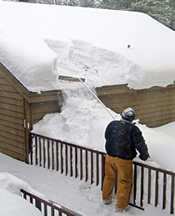 You can usually do this from the ground or from a secured ladder with a roof rake.
You can usually do this from the ground or from a secured ladder with a roof rake.
If you can reach the entire roof to clear the snow that is great but if you can’t then just clearing away the snow at the edges will often be enough to prevent heavy ice dams from forming.
Under no circumstances should you go onto the roof to clear snow or to treat ice!
Just use a roof rake.
A roof rake is a long shovel-like scraping tool.
Its unique design allows you to safely pull snow off the roof while you remain on the ground.
I reiterate my earlier point – you should never get onto a roof to remove snow.
You may see professionals doing this when they treat ice dams or to remove heavy snow fall but they are trained for the job and are using some very expensive and high-tech equipment to ensure their safety while they do it.
Using a roof rake is pretty straight forward but if you want more detailed instructions go here.
Then remove the ice in a safe manner
If you have an ice dam that is beginning to form you can treat it with a specific chemicals that help break down the ice.
Don’t bother with salt as it won’t work.
Use a calcium chloride or other type of ice melt product
to melt the ice making sure you can do this safely from a ladder or other secure place.
You can see an example of how ice melt products work to help clear away ice dams in this video.
How to remove an ice dam instructional video
As you can see preparing for winter in some areas goes way beyond getting your greenhouse sorted or frost-proofing your winter vegetables.
Remember, ice dams may look cool but they are dangerous, can cause thousands of dollars worth of damage and are potentially life-threatening.
There are a number of ice dam treatment and prevention products that can be a big help with this problem so be sure to check them out.
And also remember … stay off the roof!

